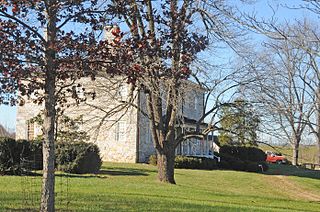
Mount Zion is a historic home located at Milldale, Warren County, Virginia. It was built in 1771–1772, and is a two-story, seven-bay, fieldstone mansion. It has a hipped roof and four interior end chimneys. The front facade features windows in a widely spaced Palladian motif on the second story.

Warrenton Historic District is a national historic district located at Warrenton, Fauquier County, Virginia. It encompasses 288 contributing buildings in the central business district and surrounding residential areas of the county seat of Warrenton. Notable buildings include the old Fauquier County courthouse (1890), Fauquier County Administration Building (1928), the former Fauquier County Public Library (1923), Fauquier National Bank (1925), "Paradise" (1758), the Thomas L. Moore House (1816), the James Caldwell House (1831), the John Quincy Marr House (1830), the Marshall Building, the California Building, old Town Hall (1854), Warrenton Presbyterian Church (1855), Ullman's Store, and "Mecca" (1859). Also located on the district are the separately listed Brentmoor and Old Fauquier County Jail.

Newport Historic District is a national historic district located at Newport, Giles County, Virginia. It encompasses 50 contributing buildings and 3 contributing sites in the rural village of Newport. The district includes primarily freestanding single-family dwellings or store buildings of one or two stories, featuring wood-frame construction, wood siding or ornamental metal sheathing, front porches, and associated outbuildings. Notable buildings include the Epling-Dunkley[or Dunklee]-Smith House (1820s-1830s), Keister-Miller House (1846), Robert Payne House (1850s), Payne-Price House, the Miller Building, the Pent Taylor Store, the Miller Brothers General Mercantile Store, F.E. Dunkley [Dunklee] Store, Pasterfield House (1903), Dr. Walter Miller House (1903-1904), Albert Price House (1904), Methodist Parsonage (1909), Newport Methodist Church, and Sinking Creek Valley Bank (1927).

Town of Halifax Court House Historic District is a national historic district located at Halifax, Halifax County, Virginia. The district includes 172 contributing buildings, 1 contributing site, 13 contributing structures, and 1 contributing object in the Town of Halifax. Resources include government, commercial, residential, religious, educational and industrial buildings that date from the early-19th Century to the mid-20th century. Notable buildings include the Rice House, Edmunds/Lewis Office (1869), People's Bank, Beth Car Baptist Church (1892), Christ Episcopal Church, Saint Luke's Christian Methodist Episcopal Church, Dr. Carter House, County Office Building (1915), Town of Halifax Swimming Pool (1930s), Municipal Building/ Fire Station (1950), Halifax Roller Mills (1915), Halifax Planing Mill, Halifax Department Store (1949), and Randolph Theater. Also located in the district is the separately listed Halifax County Courthouse.

Mineral Historic District is a national historic district located at Mineral, Louisa County, Virginia. It encompasses 222 contributing buildings, 3 contributing sites, and 6 contributing structures in the town of Mineral. It includes a variety of residential, commercial, and institutional buildings built after the town was platted in 1890. Notable buildings include the Gibson House (1915), Turner House, Dr. H. J. Judd House (1906), Odd Fellows Hall (1894), former D.E. Bumpass Department Store, former Mineral Drug Store, Bank of Louisa, C&O railroad depot (1880s), Mineral Crystal Ice Plant, Louisa County Power & Light Plant, Standard Oil Company building (1907), Episcopal Church of Incarnation (1902-1903), Mineral Baptist Church (1906), and the former Mineral School (1927).

Heathsville Historic District is a national historic district located at Heathsville, Northumberland County, Virginia. The district includes 81 contributing buildings, 12 contributing sites, 4 contributing structures, and 4 contributing objects in the county seat of Northumberland County. It is an assemblage of residential, commercial, and government buildings dating from the 18th through 20th centuries in a variety of popular architectural styles. The linear district is centered on the courthouse square. Notable buildings include the Northumberland Court House, the old county jail (1844), the former Methodist Protestant Church, Harding House, Belleville, Heathsville Masonic Lodge No. 109 (1894), Bank of Northumberland (1924), and the Heathsville United Methodist Church (1894). Located in the district and separately listed are Rice's Hotel, Oakley, St. Stephen's Church, Sunnyside, and The Academy.
Orange Commercial Historic District is a national historic district located at Orange, Orange County, Virginia. One of Virginia's Main Street communities, it encompasses 61 contributing buildings in the central business district of Orange's county seat.

Kennedy–Lunsford Farm is a historic home, farm, and national historic district located near Lexington, Rockbridge County, Virginia. The district encompasses six contributing buildings. The main house is built of stone. Additional buildings: a large bank barn, a corn crib / machinery shed, a spring house, a chicken coop and a syrup house, all date from the early 20th century.

Marion Historic District is a national historic district located at Marion, Smyth County, Virginia. The district includes 361 contributing buildings, 2 contributing sites, and 1 contributing object in the central business district and surrounding residential areas of Marion. It includes a variety of residential, commercial, institutional, industrial, and governmental buildings primarily dating from the mid-19th to mid-20th centuries. Notable buildings include the Sheffey Loom House, Odd Fellows Lodge, Look & Lincoln Wagon Factory warehouse, the Beaux-Arts style Marion County Courthouse (1905), Mt. Pleasant Methodist Church, Courtview Building (1890s), Marion High School (1907-1908), Marion Junior College (1912), the Overall Factory, Weiler Building, Bank of Marion (1922), Royal Oak Presbyterian Church (1923), Marion Municipal Building (1935), Marion Post Office (1936), and a Lustron house (1948). Also located in the district are the separately listed Hotel Lincoln, Lincoln Theatre, Marion Male Academy, and Norfolk & Western Railway Depot.

Erin is a historic home located near Front Royal, Warren County, Virginia. It was built in 1848, and is a three part Palladian plan dwelling with a two-story central section and 1+1⁄2-story flanking wings. The front facade features a two-story tetrastyle pedimented portico in the Greek Ionic order. The frame dwelling has impressive Greek Revival detailing on both its exterior and interior. Also on the property are the contributing kitchen, law office, dairy, meat smokehouse, chicken house, and granary.

Balthis House, also known as E.C. Balthis Blacksmith Shop Property and Balthis' Old Stand, is a historic home located at Front Royal, Warren County, Virginia. The original section was built about 1787, and is a two-story, five-bay, timber-frame vernacular Federal style dwelling. The original section is three bay. The house was expanded to its present size in the mid-19th century, at the same time as the addition of the two-story brick rear ell. Also on the property are the contributing kitchen dependency and playhouse / gazebo.

Killahevlin is an historic home located at Front Royal, Warren County, Virginia. It is a large 2+1⁄2-story, Queen Anne-style brick dwelling, built about 1905 for William E. Carson, president of the Riverton Lime Company.

Warren County Courthouse is a historic county courthouse complex located at Front Royal, Warren County, Virginia. It was built in 1935–1936, and is a two-story, stone faced concrete block, Colonial Revival style building. It consists of a central rectangular block with a pedimented gable roof and smaller flanking recessed wings. The central block is topped by a three-stage cupola with an open and domed belfry. Also on the property are the contributing brick clerk's office, brick jail, and two war memorials - a Confederate Monument, dedicated in 1911, and an obelisk honoring veterans of World Wars I and II.

Riverton Historic District is a national historic district located at Front Royal, Warren County, Virginia. The district encompasses 66 contributing buildings and one contributing site in the town of Front Royal. It is a primarily residential district with buildings dating from the mid-19th century and including a diverse collection of building types and architectural styles. Notable buildings include Lackawanna (1869), the Old Duncan Hotel, the Riverton United Methodist Church (1883-1890), Dellbrook, the Carson Lime Company worker's houses, and the Old Riverton Post Office and Grocery. Located in the district and separately listed is Riverside.

Front Royal Recreational Park Historic District, also known as the Front Royal Country Club, is a national historic district located near Front Royal, Warren County, Virginia. The district encompasses 3 contributing buildings, 1 contributing site, 3 contributing structures, and 1 contributing object near the town of Front Royal. The park was constructed by the Civilian Conservation Corps in 1938. The historic resources on the property include a garage, and greenskeeper's house, the golf course, the tennis courts, swimming pool, and original shelter, as well as a stone drinking fountain and a stone memorial marker. The property is operated as a public golf course by Warren County. The original clubhouse was lost in the flood of 1996 and rebuilt in 1998.

Kinsale Historic District is a national historic district located at Kinsale, Westmoreland County, Virginia. The district encompasses 65 contributing buildings in the historic core of the village of Kinsale. The district includes primarily residential and commercial buildings dating from the late-19th to early-20th centuries. Notable resources include the Bailey Cemetery, the Great House and Little House, Plain View, Captain Charles Courtney House, former Bank of Kinsale, former Palmer and Moore Kinsale Motor Corporation, Cople District Volunteer Fire Hall Department Building, Kinsale Foundation and Museum, and Kinsale Harbour Yacht Club.

Covington Historic District is a national historic district located at Covington, Virginia. The district encompasses 108 contributing buildings, 1 contributing site, and 1 contributing structure in the historic core of the city of Covington. It includes late-19th and early-20th-century commercial buildings, dwellings that date from around 1820 until 1940, and governmental, educational, religious, industrial, and transportation-related buildings. Notable buildings include Merry Stand, the James Burk House (1824), Callaghan House (1840s), William W. Lawrence House (1850s), Rinehart Building, Covington Savings Bank (1910s), I. O. O. F. Building, Covington Post Office (1914), Hotel Collins (1910), Hippodrome Theater (1920s), C&O Railway and Freight Station (1914-1915), Alleghany County Courthouse (1910), Alleghany County Jail, Sacred Heart Catholic Church, Emmanuel Episcopal Church, First Presbyterian Church (1924), and Covington Baptist Church (1902).

Hicksford–Emporia Historic District, also known as Emporia, is a national historic district located at Emporia, Virginia. The district includes 36 contributing buildings and 2 contributing objects in the Hicksford section of Emporia. In 1848, Hicksford was a stop on the Petersburg Railroad. In 1887, the neighboring towns of Hicksford and Belfield merged to form the town of Emporia. The district generally consists of late 19th century or early 20th century, when Hicksford–Emporia began to evolve from a small agricultural outpost to a large commercial and governmental center. Located at the heart of the district is the separately listed Greensville County Courthouse Complex. Other notable buildings include the Citizen's National Bank, the Widow's Son's Masonic Lodge (1905), First Presbyterian Church (1907-1908), Emporia Elementary School, Emporia Armory (mid-1930s), Greensville County Auditorium (1934), and Emporia Post Office (1938). The Old Merchants and Farmers Bank Building is also separately listed.

Downtown Salem Historic District is a national historic district located at Salem, Virginia. The district encompasses 34 contributing buildings and 1 contributing site in downtown Salem. The district includes primarily mixed-use commercial buildings, but also includes churches, dwellings, a courthouse, a post office, a library, a park, and the covered stalls of a farmer's market. The buildings mostly date from the late-19th and early-20th century and are in a variety of popular architectural styles including Greek Revival, Italianate, and Queen Anne. Notable buildings include the Stevens House or "Old Post House" (1820s-1830s), Kizer-Webber Building (1883-1886), Duval-Oakey House (1891-1898), Salem High School, Old Salem Municipal Building and Fire Department (1925), Quality Bakery Building, Olde Newberry Building (1929), Salem Theater, and James J. True Building (1927). Located in the district are the separately listed Old Roanoke County Courthouse, Salem Presbyterian Church, and Salem Post Office.

St. Paul Historic District is a national historic district located at St. Paul, Wise County, Virginia. It contains 23 contributing buildings and 2 contributing structures in the central business district of St. Paul. Most contributing resources consist of commercial buildings dating from the 1920s to 1950s. Notable buildings include the Ennis House (1887), Hillman/Ennis House, the old St. Paul Hotel (1901), National Bank building, Gaiety Movie Theater (1920s), The Lyric, and Cavalier Theater/ Phillips Building.

























